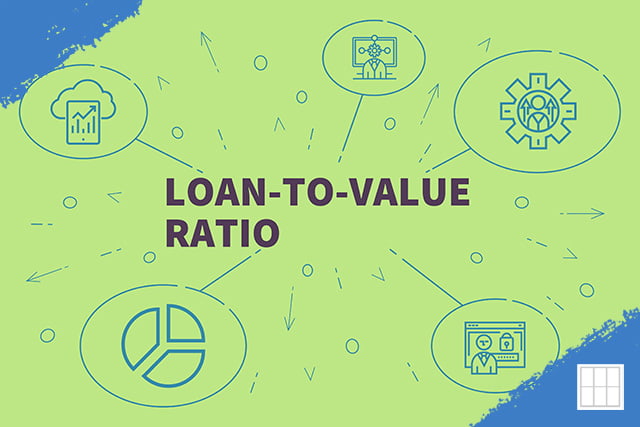When purchasing a home, taking complete stock of every aspect is critical. Vibrant flowers, freshly…

Loan-To-Value (LTV) Ratio: How does it work?
A loan-to-value (LTV) ratio compares the size of your mortgage to the value of your property. Lenders use your LTV ratio to determine your interest rate, monthly payment, and how much you can borrow.
What is a Loan-To-Value Ratio (LTV)?
A “loan-to-value” (LTV) ratio measures how much money you borrow against the appraised value of the property. It’s expressed as a percentage, and lenders usually require you to keep your LTV below a certain level.
The LTV ratio plays an essential role in the mortgage process, and it helps lenders determine how risky it is to lend money to someone and, as a result, how much interest they will charge. The lower your LTV, the less risky it is for the lender, and your interest rate will likely be lower.
If you’re in the market for a mortgage, you’ve probably heard of the loan-to-value ratio (LTV). But what is it exactly and what role does it play in getting a mortgage?
How to Calculate the loan-to-value ratio
Calculating your LTV ratio is simple: Simply multiply the loan amount by the cost or value of your home. As you’ll see in the examples below, this approach is helpful whether you’re purchasing or refinancing a home:
Purchase LTV ratios. Suppose you’re buying a home and the purchase price is $500,000, and the loan program’s maximum LTV ratio is 97%. You can determine the maximum amount you can borrow this way:
$500,000 sales price x .97 = $485,000 maximum loan amount
Refinance LTV ratios. Let’s say you are looking to refinance a home valued at $500,000, and you owe $300,000, and closing costs are $3,000. Assuming you are financing the closing costs, your new mortgage would be $303,000. Here is how to calculate your LTV:
$303,000 new loan balance divided by $500,000 value = 61% LTV ratio
Refinance cash-out LTV ratios. In this example, you want to refinance your home valued at $500,000, and your current mortgage balance is $300,000. You want to take the maximum equity in “cash-out“, and the lender’s maximum LTV for a cash-out is 80%. You would calculate the maximum cash-out this way:
$500,000 value x .80 = $400,000 minus $300,000 current mortgage balance = $100,000 available cash-out
Loan-to-value (LTV) ratio are specific to loan programs
A lender has a “maximum” LTV ratio for each loan program they offer. Generally, the maximum loan-to-value ratios apply when you’re buying a home or utilizing a streamlined refinance. If you’re taking cash out with the equity in your home with a cash-out refinance, you can expect a lower maximum LTV.
Here are the maximum LTV ratio limits for common types of loans used to either buy or refinance a single-family home:
| Loan program | Loan purpose | Maximum LTV |
|---|---|---|
| Conventional Loans | Purchase | 97% |
| Rate-and-term refinance | 97% | |
| Cash-out refinance | 80% | |
| FHA Loans | Purchase | 96.5% |
| Rate-and-term refinance | 97.75% | |
| Cash-out refinance | 80% | |
| VA Loans | Purchase | 100% |
| Rate-and-term refinance | 100% | |
| Cash-out refinance | 90% | |
| USDA Loans | Purchase | 100% |
| Rate-and-term refinance | 100% | |
| Cash-out refinance | Not allowed |
LTV vs. combined LTV (CLTV)
If you are taking out a home equity loan or home equity line of credit (HELOC), you will likely come across the term “combined-loan-to-value (CLTV) ratio.” This term refers to the combined balances, first mortgage, and home equity loan against the value of your home.
For example, let’s say you own a home worth $500,000 and you owe $250,000. You want to refinance and take out $50,000 in equity, resulting in a new mortgage of $300,000. Your combined-loan-to-value would be 60% ($300,000 divided by $500,000).
What is a Good Loan-to-Value Ratio?
Generally, a good LTV is around 80% or lower, provides a borrower with better loan terms, and avoids private mortgage insurance (PMI), which can save you thousands of dollars.
Should the LTV come in higher than 80%, you will likely pay private mortgage insurance, which mitigates the lender’s risk, protects them against default, and paves the way for mortgage lenders to lend higher to higher LTVs.
Tips to lower your Loan to Value ratio.
If your have a high LTV, consider taking one or more of the following tips to lower your LTV while boosting your homes equity:
Ask for a gift to help with your down payment. A family member, employer, or friend can gift funds for your down payment amount and closing costs.
Make a larger down payment. Saving for a larger down payment isn’t always easy but applying more funds to the down payment is one of the quickest ways to help you lower your LTV. Increasing your down payment reduces the amount of money you’re requesting to borrow, lowering your LTV. Using a mortgage calculator, you can quickly determine how much bigger down payment will affect your monthly payment.
Search for lower priced homes. If you are having trouble affording a higher down payment, look around for more reasonably priced real estate. If you keep your down payment the same, buying a property at a lower price can help lower your LTV.
In Conclusion
The loan-to-value (LTV) ratio is a necessary calculation used by lenders to determine a borrower’s risk. This post has explained the LTV ratio, how it is determined, and some ways to lower it. If you are in the market for a new home, ask your lender about your specific LTV to understand how it will impact your borrowing power.
Metropolitan Mortgage has been in business since 1997, and we have assisted many home buyers in the Midwest. If you are looking for mortgage financing in Overland Park and the greater Kansas City metropolitan area, we can help. Metropolitan Mortgage offers mortgage programs in Kansas and Missouri.


